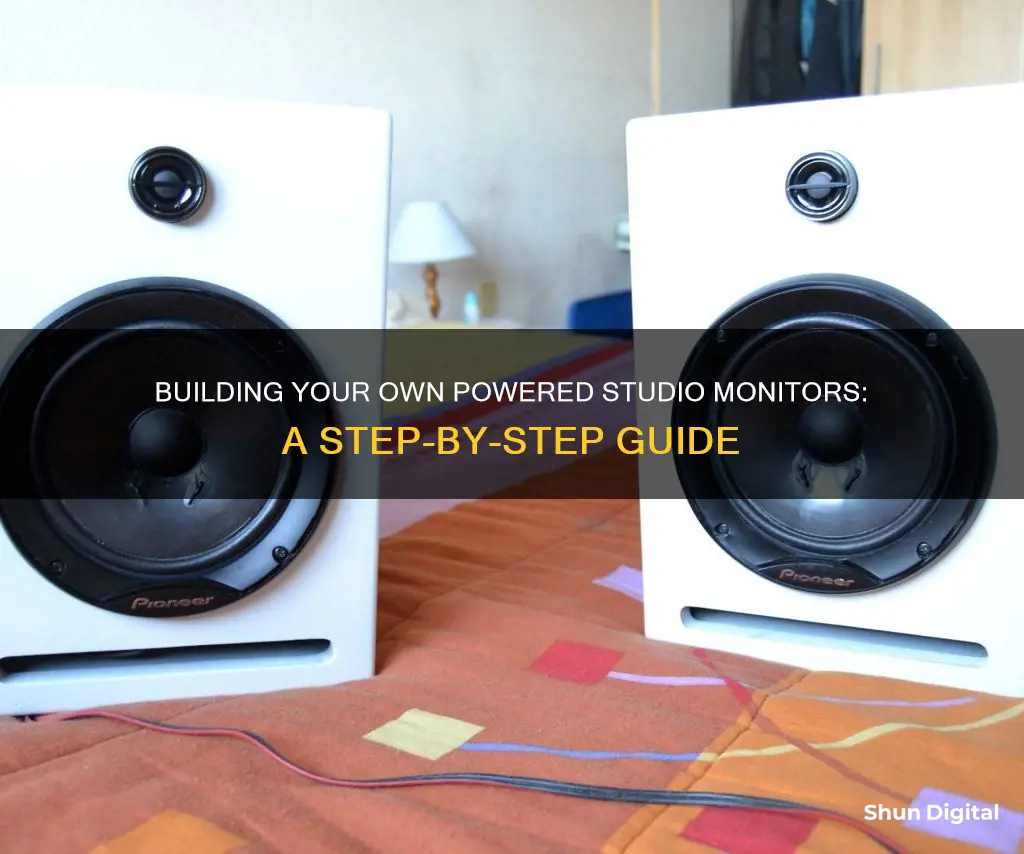
Building your own studio monitors can be a fun and creative project. However, it's important to note that DIY doesn't necessarily mean cheaper, and the cost can vary from $200 to a much higher amount depending on your choices. The first step is to choose your speakers, considering factors such as impedance and power. You'll also need to design and build an enclosure, which can be made from wood, plastic acrylic, or other materials. The enclosure design can be as simple or complex as you like, using software such as Adobe Photoshop or 3D modelling tools. Once you've built the enclosure, you can paint it to your desired finish. Finally, you'll need to power your speakers, which can be done using a car amplifier and a suitable power supply.
What You'll Learn

Choosing the right speakers
Speaker Type
You'll need to decide whether to go for passive or active speakers. Passive speakers require a separate amplifier, while active speakers have a built-in amplifier, which offers convenience and ensures the amplifier is specifically matched to the speaker. Active speakers are a more common choice for studio monitors and can deliver excellent performance.
Power Handling
The power handling, or wattage, of your speakers will impact the overall sound and dynamic range. Higher wattage provides more headroom, allowing you to hear transient details and make precise adjustments to your mix. It's important to have sufficient power to handle music peaks without distortion or clipping.
Driver Types
Studio monitors typically have a tweeter for high frequencies and a woofer for low and midrange frequencies. Some may also have a dedicated midrange driver. The materials used in the drivers, such as Kevlar or aluminium alloys, can impact the sound, so consider the benefits of different materials for your specific application.
Cabinet Design
Consider whether you want ported or closed cabinets. Ported cabinets help extend the low-frequency response, giving more bass, but may be less accurate. Closed cabinets tend to provide more precise monitoring. If you're placing your monitors near walls or in a small room, front-ported or closed designs are often a better choice to avoid bass build-up.
Features
Many studio monitors offer EQ settings and room correction features to help you optimise the sound for your space. While these can be useful, remember that they can't compensate for poor room acoustics. Acoustic treatment, such as bass traps and sound-absorbing materials, is essential for accurate monitoring.
Subwoofers
Whether you need a subwoofer depends on the type of audio work you do. If you're mixing for TV, film, or dance music, a subwoofer is essential to hear the lowest bass octaves accurately. However, for music that will be played on iPod or car systems, a subwoofer may not provide significant benefits.
Placement and Isolation
Proper placement of your studio monitors is crucial. They should form an equilateral triangle with your head when seated in the mix position. Speaker stands with isolation pads are recommended to improve sound accuracy and reduce sound reflections from surrounding surfaces.
Ankle Bracelet Voice Monitoring: Project Lifesaver's Features Explored
You may want to see also

Designing the enclosure
The enclosure is the box that houses your studio monitor system. Designing the enclosure involves several important considerations to ensure optimal sound quality and performance. Here are the key steps and factors to keep in mind:
Determine the Type of Enclosure
First, decide on the type of enclosure you want to build. The two main options are a ported system or a passive radiator enclosure. Ported systems use a port to allow air to move in and out of the enclosure, while passive radiator enclosures achieve a similar effect without a port, using a passive radiator instead. Passive radiators allow for lower tunings in smaller boxes and eliminate port whistling but are generally more expensive and have a slower transient response.
Select the Right Materials
The choice of materials for your enclosure is crucial. Wood, especially MDF wood, is commonly used due to its acoustic properties and ease of construction. If you're using wood, consider double-walled birch plywood for added strength and to prevent cabinet resonances that can affect sound quality. Ensure the walls are thick enough, typically around 1.5 inches, to provide ample support and reduce unwanted vibrations. Additionally, consider using a sealer or marine-grade epoxy to protect the wood, especially if you plan to use your studio monitors in a humid environment.
Calculate the Enclosure Volume
The volume of the enclosure will depend on the type of system you're building and the specific drivers you've chosen. For example, if you're using a ported system with an Audax HM210C0 8" Carbon Fiber Woofer, Audax recommends a volume of 2 cubic feet for an F3 of 40 hertz. This provides ample internal volume for the woofer to achieve a deep and responsive low-frequency response.
Separate Chambers for Different Drivers
It's important to design the enclosure with separate chambers for the woofer and mid-range drivers. This isolation ensures that the movement of one driver doesn't affect the other, reducing distortion and improving overall sound clarity. The mid-range enclosure should be smaller, typically around 0.6 cubic feet, and may have a non-flat back wall to optimise sound reflection.
Acoustic Treatment
To enhance the sound quality and reduce unwanted reflections and standing waves, consider acoustic treatment for the inside of the enclosure. Rock wool or mineral wool insulation are commonly used materials for acoustic treatment as they effectively dampen sound across a wide frequency range. By filling the bass and mid-range chambers with these materials, you can improve the overall sound reproduction and create a more controlled acoustic environment.
Is Your Snapchat Being Monitored? Signs to Watch For
You may want to see also

Building the enclosure
Firstly, you need to decide on the design of your enclosure. This includes determining the size, shape, and material of the box. For studio monitors, wooden enclosures are typically used, with MDF wood and plywood being popular choices. Consider the dimensions of your speakers when designing the enclosure to ensure they will fit snugly. You can use software like Adobe Photoshop or other 3D software to draw a scale template and plan out the measurements. If you're unsure where to start, you can search online for existing designs and modify them to suit your needs.
Once you have your design ready, it's time to start building the enclosure. You can attempt this yourself if you have woodworking skills, or you can hire a carpenter to ensure a professional finish. Cut the wood according to your measurements and assemble the pieces to form the box. Remember to include framing to support the weight of the speakers and other components. Use strong wood glue and screws to hold the pieces together. If you're using plywood, consider using double-walled construction for added strength and to prevent cabinet resonances that can affect sound quality.
After assembling the enclosure, you'll need to seal and paint it. Use a marine-grade epoxy or another suitable sealer to protect the wood, especially if you plan to use your studio monitors in a humid environment. As for the paint, a car primer followed by acrylic paint will give your enclosure a smooth and durable finish. You can also consider veneering or wrapping your enclosure with a plastic membrane for a different aesthetic.
Finally, install the speakers and other components into the enclosure. Make sure to leave enough space at the back of the enclosure for ventilation and heat dissipation. You can mount the plate amplifier on the back, following the manufacturer's instructions. Ensure that the speakers are securely fastened and that all wiring is connected correctly. Test the studio monitors to ensure they are functioning properly and make any necessary adjustments.
Building your own studio monitor enclosures can be a rewarding project, allowing you to customise the design, materials, and finish to your exact specifications. Remember to take your time, plan carefully, and seek professional help if needed to ensure the best results.
Signs Your LED Monitor is Failing
You may want to see also

Painting the enclosure
Materials:
Before you begin painting, ensure you have all the necessary materials, including a can of plastic primer, spray paint in your desired colour (matte black, for example), spray matte varnish, masking tape, a spray trigger, iron wool, alcohol, latex gloves, and protective paper. It is also recommended to work in a well-ventilated area and wear a breathing mask to avoid inhaling toxic fumes.
Process:
- Disassemble the monitor: Start by carefully disassembling the monitor into its separate parts, such as the screen and the arm.
- Mask unwanted areas: Use masking tape to cover any surfaces that you do not want to be painted, such as the screen and any electrical components.
- Clean the plastic surface: Use steel wool and alcohol to clean the plastic surface of the enclosure. This step helps create a smooth and clean surface for the paint to adhere to.
- Prime the plastic: Apply a thin layer of plastic primer to the enclosure using the spray trigger. This step ensures that the paint will adhere well to the plastic surface.
- Spray paint the enclosure: Once the primer is dry, apply thin layers of your chosen spray paint colour. Allow each layer to dry for about 15 minutes before applying the next. Continue this process until you achieve a uniform coat without any dips.
- Coat with varnish: After the paint is completely dry, apply a coat of matte varnish to protect the finish and create a smooth surface. Use light layers at a distance of about 25 cm, allowing each layer to dry before applying the next.
- Remove the masking tape: Once the paint and varnish are completely dry, carefully remove the masking tape from all protected areas.
- Clean residue: Use a screen cleaner to remove any glue residue left by the masking tape. Avoid using glue remover, as it can damage the screen.
By following these steps, you will have a professionally painted enclosure for your powered studio monitors.
Connecting Your APM PC: Monitor Setup Guide
You may want to see also

Connecting and testing
Connecting your monitors
To connect your studio monitors to your computer, you will need an audio interface and two cables. The audio interface will have at least two outputs, labelled 1 and 2, or L and R, to correspond to the left and right speakers. Depending on the monitors you have, you may need an XLR or a 1/4-inch jack cable to plug into the monitors, with another 1/4-inch jack plugged into your interface’s outputs.
The next step is to identify the inputs on your monitors. These will come either as a 3-pin XLR input, a 1/4-inch jack input, or perhaps both, and they offer the best sound fidelity. It’s important to ensure that your 1/4-inch speaker cables are balanced or in TRS format (often referred to as stereo jack). You can identify this through the two black rings on the jack connector instead of one. This type of cable reduces unwanted noise and maintains the integrity of your signal, which is a significant benefit.
Positioning your monitors
When positioning your monitors, the most important thing to consider is height and angle. Whatever your space and setup, the high-frequency drivers of your monitors should be at ear height relative to you. This helps your ears receive more direct sound from your monitors, resulting in a richer and more detailed listening experience. This same principle applies to the angle of your monitors. If you don’t position your monitors towards your ears, you’ll hear more reflections from some of the other surfaces in your studio. This combined sound gives you a less accurate picture of what’s going on, making it harder to mix.
Consider your two speakers as two points of a triangle, with your head being the third. Ideally, you want the distance between your pair of monitors to be equal to how far back your head is from them – on all sides. This means that, for the same reasons as we want monitors to be at the same height as our ears, we also want them to be angled towards our ears. This ensures that you get a more accurate sense of the stereo field, so you can get accurate panning.
Your monitors should also be placed around 8 to 12 inches away from any walls and corners. This should help prevent reflections from your front walls.
Testing your monitors
Once you have the right setup, you’ll need to think about improving your sound further with acoustic treatment and measuring your room. There are a few different ways you can go about doing this, depending on what monitors you have. For example, Neumann and Genelec monitors have their own room alignment systems. Some bundles of their monitors may come with measurement microphones of their own, or you might need to buy a dedicated one.
Alternatively, for those on a budget, if you’re willing to do a little work, free software like Room EQ Wizard and purchasing a good, separate measurement microphone will let you profile your room so you can see exactly what you need to treat, build plans for your acoustic treatment, and see what control and dip switch settings you might need to use to improve the response of your monitors.
When reading this measurement chart, understand that you’ll never be able to get your room response completely flat; it’s an unfortunate reality of sound in any enclosed space. However, any significantly large bumps or dips can definitely be addressed through proper acoustic treatment and speaker adjustment.
Whatever approach you use, set up your microphone in your listening position, and then activate your measurement system. This will usually play some form of noise—white or pink typically—or sweep frequencies. This can get harsh to listen to as it works, but it helps the microphone understand exactly how your space responds to each frequency with incredible accuracy.
Cleaning an LCD Monitor: Tips and Tricks
You may want to see also
Frequently asked questions
Studio monitors are made up of a woofer for low frequencies and a tweeter for high frequencies. High-end models also include a supplementary loudspeaker dedicated to medium frequencies.
There are active and passive studio monitors. Active monitors have built-in amplifiers and are simpler to use, while passive monitors require external amplifiers and offer more flexibility.
It depends on your setup. Single-amp is the most common setup for passive monitors. Bi-amp provides better control over frequency and is often used in professional studios. Tri-amp configurations are the most advanced and complex, providing the ultimate control over frequency response and are used in high-end professional studios.
The size of the studio monitor depends on your room size and music style. If you work with EDM, for example, you will need better low-frequency response and a bigger driver size. For a home studio, 5-inch speakers are a good fit. As for wattage, if you're starting out or working in a small to medium-sized room, 50-75 watts per channel is a good starting point.







